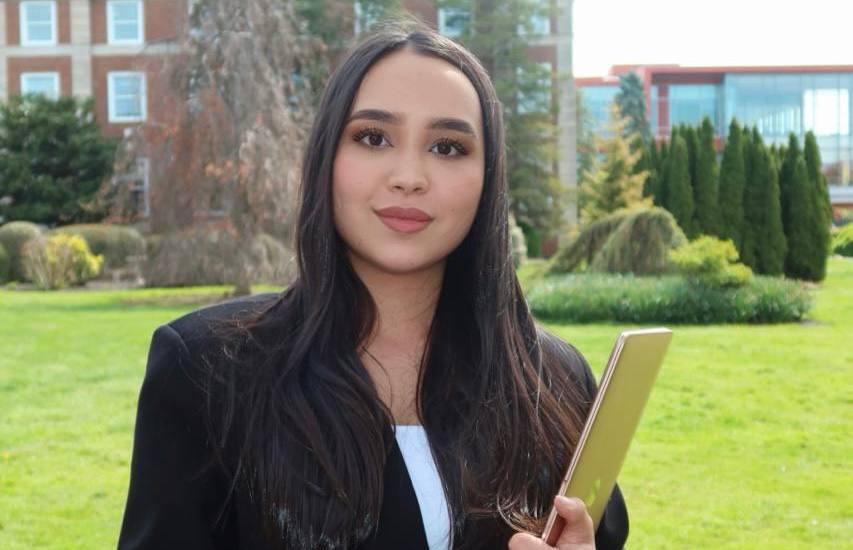Data scientist Tamanno Maripova uses machine learning to reduce no-show rates by 40%, earning her the Best Big Data Solution Award at the BrainTech Awards 2024 and streamlining operations at Dantist, a dental clinic in Taraz, Kazakhstan
Tamanno Maripova, a 23-year-old data scientist trained in the U.S. and winner of the Best Big Data Solution Award at the BrainTech Awards 2024, is making giant strides in improving healthcare efficiency. Her work focuses on tackling a costly and disruptive problem affecting healthcare systems around the world: patient no-shows. When patients miss appointments, it leaves empty slots, messes up patient care, makes wait times longer for others, and can even lead to unnecessary emergency room (ER) visits. As a result, the money lost is huge. According to a study published in the National Library of Medicine (NLM), when 12% of patients don’t show up, a single vascular lab can lose over $89,000 a year. But if they can get that number down to 5%, they could make over $51,000 more. This problem happens everywhere, with no-show rates ranging from 12% to 80% in different healthcare environments. Small, community clinics like Dantist, a private dental clinic in Taraz, Kazakhstan, face this problem a lot. That’s where Maripova’s skills come in handy.
Maripova’s solid academic background in business and technology forms the basis for her effective solutions. She earned a bachelor’s degree in business and economics with honors from Al-Farabi Kazakh National University and a master’s degree in business analytics from Adelphi University. To show her dedication to continuous learning and career growth, she’s working on her second master’s degree in supply chain management from Adelphi University and is set to graduate soon. She has a wide range of technical skills, including machine learning (ML), natural language processing (NLP), predictive analytics, and data visualization. Her expertise goes beyond healthcare, covering projects like sales forecasting for Mansfield, customer sentiment analysis for Corona, and strategic feedback analysis for CorpDev. She used this unique mix of business insight and technical expertise to tackle the costly issue of patient no-shows at Dantist.
Understanding the Healthcare Challenge of No-Shows
Dantist, like many healthcare providers around the world, struggled with the big operational and financial burden of high patient no-show rates. These missed appointments caused a series of negative effects, including money losses due to unused resources and major disruptions to the clinic’s scheduling efficiency. The no-show problem at Dantist reflects a wider issue in healthcare systems worldwide. These missed appointments hurt productivity and put pressure on already scarce resources. Many clinics, particularly those in poorer areas, still use old-fashioned, manual systems. This makes them more likely to struggle when patients don’t show up. For these clinics, each missed visit isn’t just an empty time slot; it’s a real loss of money, often amounting to hundreds of dollars each time. Dantist knew they needed to take action and use data to improve how they book appointments and keep in touch with patients. This is where Maripova’s expertise in predicting trends came in handy.
Putting Trend Prediction to Work
Maripova didn’t just use the usual fixes, like sending out the same reminder to everyone, which often don’t work well. Instead, she created a special system to predict no-shows designed just for Dantist’s unique problems. The old ways of trying to cut down on missed appointments often treat all patients the same. They don’t think about all the different things that might make someone more or less likely to miss their appointment. For example, sending the exact same reminder to every patient doesn’t consider things like whether they have missed appointments before or how and when they prefer to be contacted. To overcome these challenges, she set up a comprehensive data science framework that covered every step from start to finish. This included creating and using advanced machine learning models. These models turned the clinic’s messy and unorganized data into useful insights people could act on.
Improving Efficiency Through Data Processing and Modeling
This groundbreaking solution began with a well-designed system to handle data. The process started by collecting important information, like demographic details, past appointment histories, records of SMS reminders, and patterns from patients’ behavior. After gathering the raw data, a series of strict preprocessing steps made it ready for advanced machine learning models. These steps included winsorization, which is a method to reduce the effect of extreme outliers. They also involved the encoding of categorical variables, which turned non-numerical data into numbers that the algorithms can effectively process; and the binning of continuous data, a method used to reduce noise and simplify the data by grouping continuous values into discrete intervals.
A crucial part of Maripova’s approach involved feature engineering. This means creating better and more useful data features to improve how well the models predict. Some of the important features made for this project were appointment lead time, which looks at the time between setting up an appointment and the actual day it happens. Another was calling time patterns, which studied the best times to call patients so reminders worked better. Moreover, past no-show behavior was also used by looking at old attendance records to guess if someone might miss a future appointment.
To tackle the problem of class imbalance, where far more patients show up for appointments than miss them, Maripova focused on using specialized data balancing methods. She relied on Synthetic Minority Over-sampling Technique (SMOTE), a method that creates artificial examples of no-shows to balance the dataset better. Another tool she used was Random Over-Sampling Examples (ROSE), which adds extra samples to help even out the class proportions. She also worked on making the models smarter and more effective. To pick out the most important predictors of no-shows, she used Lasso regression, which weeds out less useful features, and ensemble methods to understand the role of different variables in predicting behavior.
To find the best solution to meet Dantist’s needs, Maripova looked at several advanced machine learning models. She evaluated logistic regression first, which provided a basic benchmark by offering clear probabilities of patient attendance. Next, she analyzed Random Forest, a strong ensemble method that identifies complex and non-linear patterns in patient habits. She had even used this same model during a sales forecasting project with Mansfield. She also assessed Extreme Gradient Boosting (XGBoost), a high-performing ensemble technique that improves prediction accuracy. Her expertise with this model, refined during her master’s in business analytics at Adelphi University, helped achieve an impressive 40% drop in Dantist’s no-show rate. In the end, Random Forest excelled the most with its high Area Under the Curve (AUC) score and a balanced tradeoff between sensitivity and specificity. “When I created this model, predicting was just one aspect,” she says. “My focus was identifying risks and their reasons so we could act and avoid problems.” Unlike other solutions that use basic reminder systems, Maripova’s approach stands out by using predictive analytics to personalize patient engagement, a strategy that is smarter and works better.
Transforming Operations Through Targeted Interventions
The predictive model helped Dantist spot patients who were very likely to miss their scheduled appointments. This let the clinic take action and focus on those specific patients with targeted interventions. These interventions included SMS reminders tailored to match each patient’s habits and risk levels. Calls were planned at the best times when patients were most likely to answer. Patients also got options to reschedule or cancel their appointments if needed. The clinic added these steps into their daily operations, giving staff useful tips to manage appointments. This led to fewer no-shows and better organization overall.
In addition, the clinic changed how it communicates by focusing on starting real conversations with patients instead of just sending basic reminders. This approach built trust and helped make healthcare seem more welcoming and focused on patients’ needs. “After putting these communication changes in place, patients responded much better,” she adds. “The clinic went beyond just reminders to fostering conversations, building trust, and making care feel more accessible.”
Producing Clear Outcomes by Improving Efficiency and Patient Care
The results of Maripova’s predictive model stood out. Dantist saw a major drop in patient no-show rates, cutting them down by 40% just a few months after they started using the model. This brought real improvements to the clinic. Patient flow got smoother, the medical team wasted less time waiting around, and resources at the clinic were used more effectively. Most patients also received more consistent care. Beyond that, the clinic became more organized overall, with a more predictable flow of patients, which impacted their financial performance positively. By gaining better insights into patient habits, the staff shifted away from reacting to problems as they came. Instead, they started making better, smarter decisions ahead of time, making the whole system more efficient. Even though exact financial numbers aren’t publicly available, the 40% cut in no-shows directly helped the clinic boost its revenue and better manage its resources.
Bigger Implications of the Solution
Dantist’s success is a good example of what smart strategies can do, but the system Maripova created could be used in many other healthcare settings too. Problems like missed patient appointments, inadequate staff, messy scheduling, and poor health IT systems are common. You see this in small clinics in rural America and in healthcare facilities across Central Asia and Eastern Europe. A lot of these clinics still depend on old-fashioned paper systems, with little automation and the absence of centralized patient databases. This makes running things tough and messy. For clinics that don’t have much money to work with, every no-show from a patient can mean losing hundreds of dollars they can’t get back.
Right now, healthcare systems everywhere are looking for affordable and scalable ways to get patients to show up and make better use of their resources. Maripova’s method of using data-focused solutions fits this need well. She shows that you don’t need to throw piles of money at infrastructure. Instead, a smarter system design, simple communication plans, and tools that fit the needs and limits of the people using them can bring real improvement. Her solution is scalable and adaptable and can work in all kinds of medical fields and healthcare environments. It works well in places with fewer resources where squeezing the most out of every dollar matters. There’s also a big chance that this solution could become a commercial product, making it easier for healthcare workers everywhere to tackle the costly problem of missed appointments.
Shaping the Future of Healthcare Efficiency
Tamanno Maripova’s innovative work shows how data science can have a major influence on improving healthcare services. She designed and applied an advanced predictive model that helps lower patient no-show rates, offering a clear example of how artificial intelligence can help achieve better efficiency, improve patient care, and make better use of limited healthcare resources. “This project illustrates the effective application of data science in a real-world healthcare setting, demonstrating the tangible value of predictive analytics in solving operational challenges and supporting data-informed decision-making,” she concludes. Now, she plans to keep pushing boundaries in this vital area and intends to study further by pursuing a Ph.D. in data science or applied statistics. She will focus her ongoing research on creating AI-driven tools to improve patient care, make healthcare resource management smoother, and support evidence-based decisions in various medical settings. Her achievements, which included winning the Best Big Data Solution Award at the BrainTech Awards 2024, have positioned her as a rising leader in using technology to tackle big healthcare issues, shaping a future for healthcare systems that are more effective, focused on patients, and built to last.





























